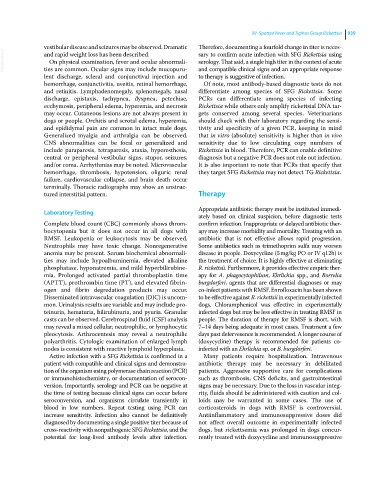Page 1001 - Clinical Small Animal Internal Medicine
P. 1001
99 Spotted Fever and Typhus Group Rickettsia 939
vestibular disease and seizures may be observed. Dramatic Therefore, documenting a fourfold change in titer is neces-
VetBooks.ir and rapid weight loss has been described. sary to confirm acute infection with SFG Rickettsia using
serology. That said, a single high titer in the context of acute
On physical examination, fever and ocular abnormali-
ties are common. Ocular signs may include mucopuru-
lent discharge, scleral and conjunctival injection and and compatible clinical signs and an appropriate response
to therapy is suggestive of infection.
hemorrhage, conjunctivitis, uveitis, retinal hemorrhage, Of note, most antibody‐based diagnostic tests do not
and retinitis. Lymphadenomegaly, splenomegaly, nasal differentiate among species of SFG Rickettsia. Some
discharge, epistaxis, tachypnea, dyspnea, petechiae, PCRs can differentiate among species of infecting
ecchymosis, peripheral edema, hyperemia, and necrosis Rickettsia while others only amplify rickettsial DNA tar-
may occur. Cutaneous lesions are not always present in gets conserved among several species. Veterinarians
dogs or people. Orchitis and scrotal edema, hyperemia, should check with their laboratory regarding the sensi-
and epididymal pain are common in intact male dogs. tivity and specificity of a given PCR, keeping in mind
Generalized myalgia and arthralgia can be observed. that in vitro (absolute) sensitivity is higher than in vivo
CNS abnormalities can be focal or generalized and sensitivity due to low circulating copy numbers of
include paraparesis, tetraparesis, ataxia, hyperesthesia, Rickettsia in blood. Therefore, PCR can enable definitive
central or peripheral vestibular signs, stupor, seizures, diagnosis but a negative PCR does not rule out infection.
and/or coma. Arrhythmias may be noted. Microvascular It is also important to note that PCRs that specify that
hemorrhage, thrombosis, hypotension, oliguric renal they target SFG Rickettsia may not detect TG Rickettsia.
failure, cardiovascular collapse, and brain death occur
terminally. Thoracic radiographs may show an unstruc-
tured interstitial pattern. Therapy
Appropriate antibiotic therapy must be instituted immedi-
Laboratory Testing
ately based on clinical suspicion, before diagnostic tests
Complete blood count (CBC) commonly shows throm- confirm infection. Inappropriate or delayed antibiotic ther-
bocytopenia but it does not occur in all dogs with apy may increase morbidity and mortality. Treating with an
RMSF. Leukopenia or leukocytosis may be observed. antibiotic that is not effective allows rapid progression.
Neutrophils may have toxic change. Nonregenerative Some antibiotics such as trimethoprim sulfa may worsen
anemia may be present. Serum biochemical abnormali- disease in people. Doxycycline (5 mg/kg PO or IV q12h) is
ties may include hypoalbuminemia, elevated alkaline the treatment of choice. It is highly effective at eliminating
phosphatase, hyponatremia, and mild hyperbilirubine- R. rickettsii. Furthermore, it provides effective empiric ther-
mia. Prolonged activated partial thromboplastin time apy for A. phagocytophilum, Ehrlichia spp., and Borrelia
(APTT), prothrombin time (PT), and elevated fibrin- burgdorferi, agents that are differential diagnoses or may
ogen and fibrin degredation products may occur. co‐infect patients with RMSF. Enrofloxacin has been shown
Disseminated intravascular coagulation (DIC) is uncom- to be effective against R. rickettsii in experimentally infected
mon. Urinalysis results are variable and may include pro- dogs. Chloramphenicol was effective in experimentally
teinuria, hematuria, bilirubinuria, and pyuria. Granular infected dogs but may be less effective in treating RMSF in
casts can be observed. Cerebrospinal fluid (CSF) analysis people. The duration of therapy for RMSF is short, with
may reveal a mixed cellular, neutrophilic, or lymphocytic 7–14 days being adequate in most cases. Treatment a few
pleocytosis. Arthrocentesis may reveal a neutrophilic days past defervesence is recommended. A longer course of
polyarthritis. Cytologic examination of enlarged lymph (doxycycline) therapy is recommended for patients co‐
nodes is consistent with reactive lymphoid hyperplasia. infected with an Ehrlichia sp. or B. burgdorferi.
Active infection with a SFG Rickettsia is confirmed in a Many patients require hospitalization. Intravenous
patient with compatible and clinical signs and demonstra- antibiotic therapy may be necessary in debilitated
tion of the organism using polymerase chain reaction (PCR) patients. Aggressive supportive care for complications
or immunohistochemistry, or documentation of serocon- such as thrombosis, CNS deficits, and gastrointestinal
version. Importantly, serology and PCR can be negative at signs may be necessary. Due to the loss in vascular integ-
the time of testing because clinical signs can occur before rity, fluids should be administered with caution and col-
seroconversion, and organisms circulate transiently in loids may be warranted in some cases. The use of
blood in low numbers. Repeat testing using PCR can corticosteroids in dogs with RMSF is controversial.
increase sensitivity. Infection also cannot be definitively Antiinflammatory and immunosuppressive doses did
diagnosed by documenting a single positive titer because of not affect overall outcome in experimentally infected
cross‐reactivity with nonpathogenic SFG Rickettsia, and the dogs, but rickettsemia was prolonged in dogs concur-
potential for long‐lived antibody levels after infection. rently treated with doxycycline and immunosuppressive

